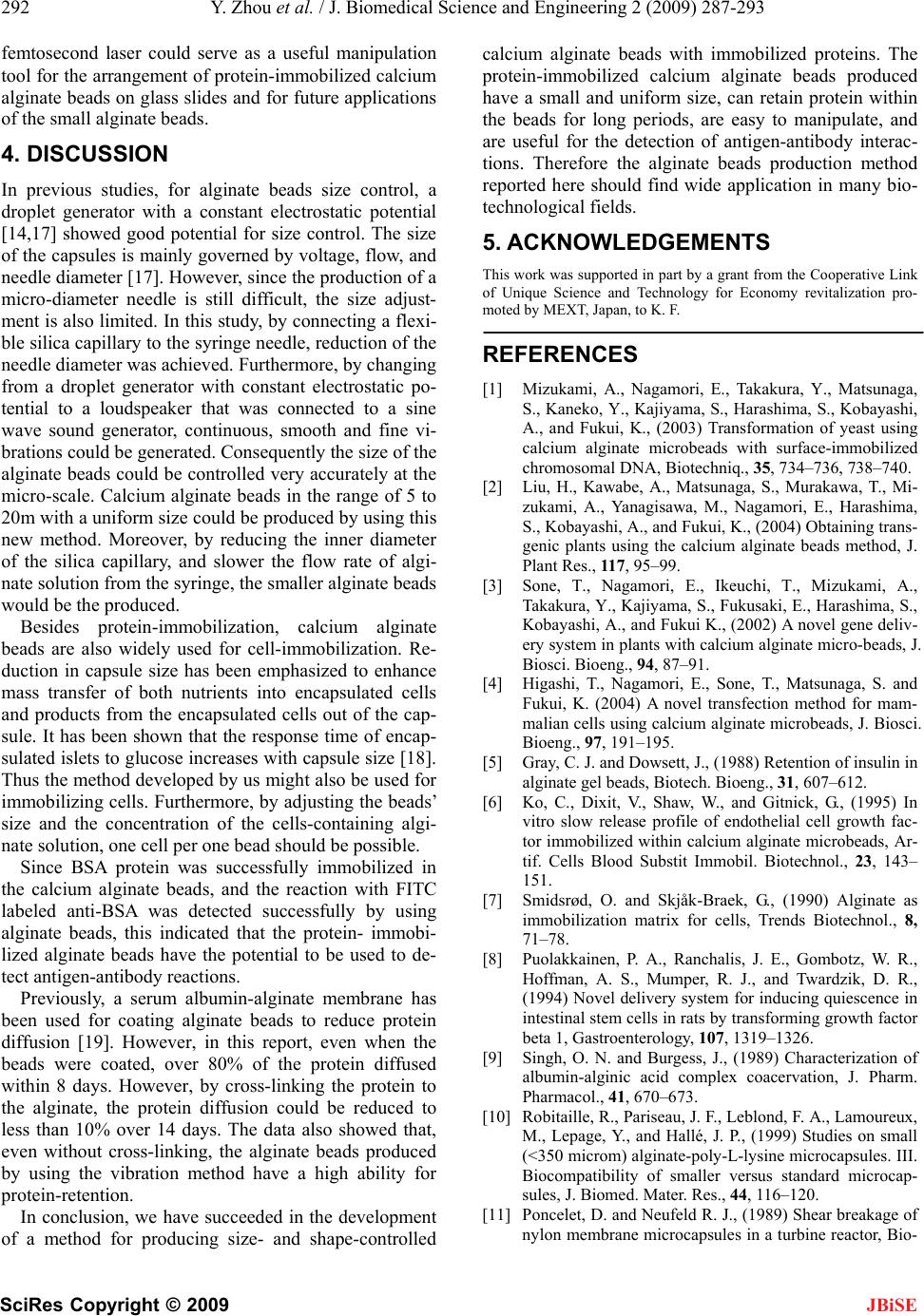
292 Y. Zhou et al. / J. Biomedical Science and Engineering 2 (2009) 287-293
SciRes Copyright © 2009 JBiSE
femtosecond laser could serve as a useful manipulation
tool for the arrangement of protein-immobilized calcium
alginate beads on glass slides and for future applications
of the small alginate beads.
4. DISCUSSION
In previous studies, for alginate beads size control, a
droplet generator with a constant electrostatic potential
[14,17] showed good potential for size control. The size
of the capsules is mainly governed by voltage, flow, and
needle diameter [17]. However, since the production of a
micro-diameter needle is still difficult, the size adjust-
ment is also limited. In this study, by connecting a flexi-
ble silica capillary to the syringe needle, reduction of the
needle diameter was achieved. Furthermore, by changing
from a droplet generator with constant electrostatic po-
tential to a loudspeaker that was connected to a sine
wave sound generator, continuous, smooth and fine vi-
brations could be generated. Consequently the size of the
alginate beads could be controlled very accurately at the
micro-scale. Calcium alginate beads in the range of 5 to
20m with a uniform size could be produced by using this
new method. Moreover, by reducing the inner diameter
of the silica capillary, and slower the flow rate of algi-
nate solution from the syringe, the smaller alginate beads
would be the produced.
Besides protein-immobilization, calcium alginate
beads are also widely used for cell-immobilization. Re-
duction in capsule size has been emphasized to enhance
mass transfer of both nutrients into encapsulated cells
and products from the encapsulated cells out of the cap-
sule. It has been shown that the response time of encap-
sulated islets to glucose increases with capsule size [18].
Thus the method developed by us might also be used for
immobilizing cells. Furthermore, by adjusting the beads’
size and the concentration of the cells-containing algi-
nate solution, one cell per one bead should be possible.
Since BSA protein was successfully immobilized in
the calcium alginate beads, and the reaction with FITC
labeled anti-BSA was detected successfully by using
alginate beads, this indicated that the protein- immobi-
lized alginate beads have the potential to be used to de-
tect antigen-antibody reactions.
Previously, a serum albumin-alginate membrane has
been used for coating alginate beads to reduce protein
diffusion [19]. However, in this report, even when the
beads were coated, over 80% of the protein diffused
within 8 days. However, by cross-linking the protein to
the alginate, the protein diffusion could be reduced to
less than 10% over 14 days. The data also showed that,
even without cross-linking, the alginate beads produced
by using the vibration method have a high ability for
protein-retention.
In conclusion, we have succeeded in the development
of a method for producing size- and shape-controlled
calcium alginate beads with immobilized proteins. The
protein-immobilized calcium alginate beads produced
have a small and uniform size, can retain protein within
the beads for long periods, are easy to manipulate, and
are useful for the detection of antigen-antibody interac-
tions. Therefore the alginate beads production method
reported here should find wide application in many bio-
technological fields.
5. ACKNOWLEDGEMENTS
This work was supported in part by a grant from the Cooperative Link
of Unique Science and Technology for Economy revitalization pro-
moted by MEXT, Japan, to K. F.
REFERENCES
[1] Mizukami, A., Nagamori, E., Takakura, Y., Matsunaga,
S., Kaneko, Y., Kajiyama, S., Harashima, S., Kobayashi,
A., and Fukui, K., (2003) Transformation of yeast using
calcium alginate microbeads with surface-immobilized
chromosomal DNA, Biotechniq., 35, 734–736, 738–740.
[2] Liu, H., Kawabe, A., Matsunaga, S., Murakawa, T., Mi-
zukami, A., Yanagisawa, M., Nagamori, E., Harashima,
S., Kobayashi, A., and Fukui, K., (2004) Obtaining trans-
genic plants using the calcium alginate beads method, J.
Plant Res., 117, 95–99.
[3] Sone, T., Nagamori, E., Ikeuchi, T., Mizukami, A.,
Takakura, Y., Kajiyama, S., Fukusaki, E., Harashima, S.,
Kobayashi, A., and Fukui K., (2002) A novel gene deliv-
ery system in plants with calcium alginate micro-beads, J.
Biosci. Bioeng., 94, 87–91.
[4] Higashi, T., Nagamori, E., Sone, T., Matsunaga, S. and
Fukui, K. (2004) A novel transfection method for mam-
malian cells using calcium alginate microbeads, J. Biosci.
Bioeng., 97, 191–195.
[5] Gray, C. J. and Dowsett, J., (1988) Retention of insulin in
alginate gel beads, Biotech. Bioeng., 31, 607–612.
[6] Ko, C., Dixit, V., Shaw, W., and Gitnick, G., (1995) In
vitro slow release profile of endothelial cell growth fac-
tor immobilized within calcium alginate microbeads, Ar-
tif. Cells Blood Substit Immobil. Biotechnol., 23, 143–
151.
[7] Smidsrød, O. and Skjåk-Braek, G., (1990) Alginate as
immobilization matrix for cells, Trends Biotechnol., 8,
71–78.
[8] Puolakkainen, P. A., Ranchalis, J. E., Gombotz, W. R.,
Hoffman, A. S., Mumper, R. J., and Twardzik, D. R.,
(1994) Novel delivery system for inducing quiescence in
intestinal stem cells in rats by transforming growth factor
beta 1, Gastroenterology, 107, 1319–1326.
[9] Singh, O. N. and Burgess, J., (1989) Characterization of
albumin-alginic acid complex coacervation, J. Pharm.
Pharmacol., 41, 670–673.
[10] Robitaille, R., Pariseau, J. F., Leblond, F. A., Lamoureux,
M., Lepage, Y., and Hallé, J. P., (1999) Studies on small
(<350 microm) alginate-poly-L-lysine microcapsules. III.
Biocompatibility of smaller versus standard microcap-
sules, J. Biomed. Mater. Res., 44, 116–120.
[11] Poncelet, D. and Neufeld R. J., (1989) Shear breakage of
nylon membrane microcapsules in a turbine reactor, Bio-